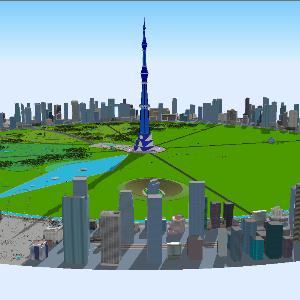Please find below the
Semi-Finalist Evaluation
Judges'' comments
- The Judges found the proposal appealing but in the end it was too much of a Brave New World, somewhat patronising, view of what people might want. The idea is that it is possible to build a perfect city that will tempt people away from areas at risk from climate change - so that migration can take place steadily instead of all at once in response to an environmental disaster. But then you have to ask - why would people want to move to these cities? What would they do? How would they earn a living? How pleasant would these cities really be, given they are to be located in arid areas? And how environmentally friendly would they really be? For example, all water is to be derived by desalination and recycling - but desalination of what (given it's an arid area at +70m altitude it may not be close to the coast)? Are they going to pump groundwater? They'd need an awful lot for a city of +1 million people - which might deplete the aquifer to dangerously low levels. And what will they do with the brine?
- As this is a climate adaptation proposal, the Judges were surprised you did not lead with the points that the cities must be developed away from the coasts. You should also add that they will be away from wildfire zones (a major climate impact) and that they will address air quality (arguably the biggest climate adaptation challenge, since hundreds of people die every day from poor air quality, which is made much worse in climate change with elevated heat). Your drawings invite the Judges to wonder if there could be ecosystems built in the greenspace - sort of like the great green wall in Africa, could the greenspace provide a geoclimate that allowed for forests to grow? This could help to mitigate the urban heat island and deal with some of the air quality concerns.
 Emil Jacob Nov 6, 2017 06:12 | Proposal creator Dear Judges, Thank you for your feedback. I apologize for the patronizing impression and would like to clarify that the CoLab city model would not infringe on what people would want but rather offer more attractive alternatives. But then you have to ask - why would people want to move to these cities? What would they do? How would they earn a living? How pleasant would these cities really be, given they are to be located in arid areas? These cities would have to grow in an organic gradual way - after an early investment till reaching a critical mass - creating demand for labor. The goal would be to have all or some of the amenities that attracts millions of migrants from Africa and south America to wealthier countries. My argument is that the model I am proposing is able to provide energy, transportation, housing, security, food and water much more cheaply than the existing cities in the West. These are the features that I believe would attract populations away from low lying coastal areas and from ecologically endangered areas. What would they do? How would they earn a living? I believe that once a few billion dollars is invested by governments and universities as wells as businesses, to create R&D and operation centers the cities will begin to grow on continued demand for goods and services from the population on-site. It is very likely that they would not need to work more than 4 hours per day. Consider that mass transit is entirely automated while food is grown in vertical farms using advanced technologies including robotics. My belief is that the populations that move to these cities will not need to work in the traditional desperate sense to struggle for a living since many of the essential needs will be attained at a lower cost.
How pleasant would these cities really be, given they are to be located in arid areas?
|
